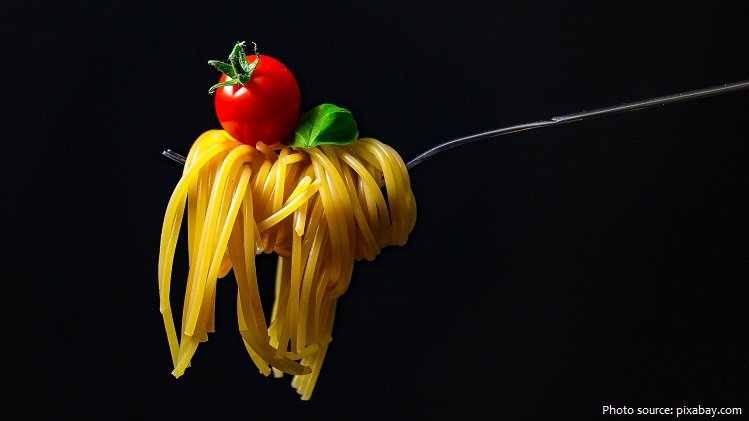
A fork Is an implement consisting of two or more prongs supported by a handle, used for cooking, serving, and eating food.
Forks and spoons together are known as flatware – the term flatware was introduced toward the end of the 19th century. Strictly speaking, it excludes knives, which are classified as cutlery, although in common American usage knives are generally included.
The modern work for fork comes from the Latin work “furca” which means “pitchfork”.

Bone forks have been found in archaeological sites of the Bronze Age Qijia culture (2400–1900 BC), the Shang dynasty (c. 1600–c. 1050 BC), as well as later Chinese dynasties. A stone carving from an Eastern Han tomb (in Ta-kua-liang, Suide County, Shaanxi) depicts three hanging two-pronged forks in a dining scene. Similar forks have also been depicted on top of a stove in a scene at another Eastern Han tomb (in Suide County, Shaanxi).
In Ancient Egypt, large forks were used as cooking utensils.
In the Roman Empire, bronze and silver forks were used, many surviving examples of which are displayed in museums around Europe. Use varied according to local customs, social class, and the type of food, but in earlier periods forks were mostly used as cooking and serving utensils.

Although its origin may go back to Ancient Greece, the personal table fork was most likely invented in the Byzantine Empire, where they were in common use by the 4th century.
Records show that by the 9th century in some elite circles of Persia a similar utensil known as a barjyn was in limited use.
By the 10th century, the table fork was in common use throughout the Middle East.
While Eastern Europe and Middle East enjoyed the comfort and usability of forks for majority of so called Middle Ages, the rest of central and western Europe still used hands as a primary means of eating. With abundance of metal in circulation, higher circles of population held tradition for every male person to carry one or two small pointy knives that were used to cut meat and as a simple “spear” for piercing the food and carrying it from plate to mouth.

According to Peter Damian the Byzantine princess Maria Argyropoulina brought some golden forks to Venice, when she married the son of the Doge in 1004. Damien condemned the fork as “vanity”.
Fast forward a few centuries, and forks had become commonplace in Italy. Again, international marriage proved the catalyst for the implement’s spread—Catherine de Medici brought a collection of silver forks
from Italy to France in 1533, when she married the future King Henry II.
In 1608, an English traveler to the continent, Thomas Coryate, published an account of his overseas observations, including the use of the fork, a practice he adopted himself. Although he was ridiculed at the time, acceptance of the fork soon followed.

At the beginning of the 17th century, forks were still uncommon in the American colonies. Expert in forks Chad Ward writes that the way Americans still eat comes from the fact that the new, blunt-tipped knives imported to the colonies made it difficult to spear food, as had been the practice. Now they had to use their spoons with their left hand to steady the food while cutting with the right hand, then switch the spoon to the right hand to scoop up a bite. The “zig-zag” method, as Emily Post called it, is particular to Americans.
The fork did not become popular in North America until near the time of the American Revolution. The standard four-tine design became current in the early 19th century.

Today, there are over 35 types of fork:
• Asparagus fork
• Barbecue fork
• Beef fork: A fork used for picking up meat. This fork is shaped like a regular fork, but it is slightly bigger and the tines are curved outward. The curves are used for piercing the thin sliced beef.
• Berry fork
• Carving fork: A two-pronged fork used to hold meat steady while it is being carved. They are often sold with carving knives or slicers as part of a carving set.
• Cheese fork
• Chip fork: A two-pronged disposable fork, usually made out of sterile wood (though increasingly of plastic), specifically designed for the eating of french fries (chips) and other takeaway foods. From 7.5 to 9 cm long. In Germany they are known as Pommesgabel (literally “chip fork”) and “currywurst fork”.
• Cocktail fork: A small fork resembling a trident, used for spearing cocktail garnishes such as olives.
• Cold meat fork
• Crab fork: A short, sharp and narrow three-pronged or two-pronged fork designed to easily extract meat when consuming cooked crab.
• Dessert fork (alternatively, pudding fork/cake fork in Great Britain): Any of several different special types of forks designed to eat desserts, such as a pastry fork. They usually have only three tines and are smaller than standard dinner forks. The leftmost tine may be widened so as to provide an edge with which to cut (though it is never sharpened).
• Dinner fork
• Extension fork: A long-tined fork with a telescopic handle, allowing for its extension or contraction.
• Fish fork
• Fondue fork: A narrow fork, usually having two tines, long shaft and an insulating handle, typically of wood, for dipping bread into a pot containing sauce
• Fruit salad fork: A fork used which is used to pick up pieces of fruit such as grapes, strawberries, melon and other varies types of fruit.
• Granny fork
• Ice cream fork: A spoon with flat tines used for some desserts. See spork.
• Knork
• Meat fork
• Olive fork
• Oyster fork
• Pastry fork
• Pickle fork: A long handled fork used for extracting pickles from a jar, or an alternative name for a ball joint separator tool used to unseat a ball joint.
• Pie fork
• Relish fork
• Salad fork: Similar to a regular fork, but may be shorter, or have one of the outer tines shaped differently. Often, a “salad fork” in the silverware service of some restaurants (especially chains) may be simply a second fork; conversely, some restaurants may omit it, offering only one fork in their service.
• Sardine fork
• Spaghetti fork: A novelty fork with a metal shaft loosely fitted inside a hollow plastic handle. The shaft protrudes through the top of the handle, ending in a crank, that allows the metal part of the fork to be easily rotated with one hand while the other hand is holding the plastic handle. This supposedly allows spaghetti to be easily wound onto the tines. Electric variations of this fork have become more prevalent in modern times.
• Sporf: A utensil combining characteristics of a spoon, a fork and a knife
• Spork: A utensil combining characteristics of a spoon and a fork.
• Sucket fork: A utensil with tines at one end of the stem and a spoon at the other. It was used to eat food that would otherwise be messy to eat such as items preserved in syrup. The tine end could spear the item, while the other end could be used to spoon the syrup.
• Tea fork
• Terrapin fork: A spoon with flat tines used for some soups. See spork.
• Toasting fork: A fork, usually having two tines, very long metal shaft and sometimes an insulating handle, for toasting food over coals or an open flame